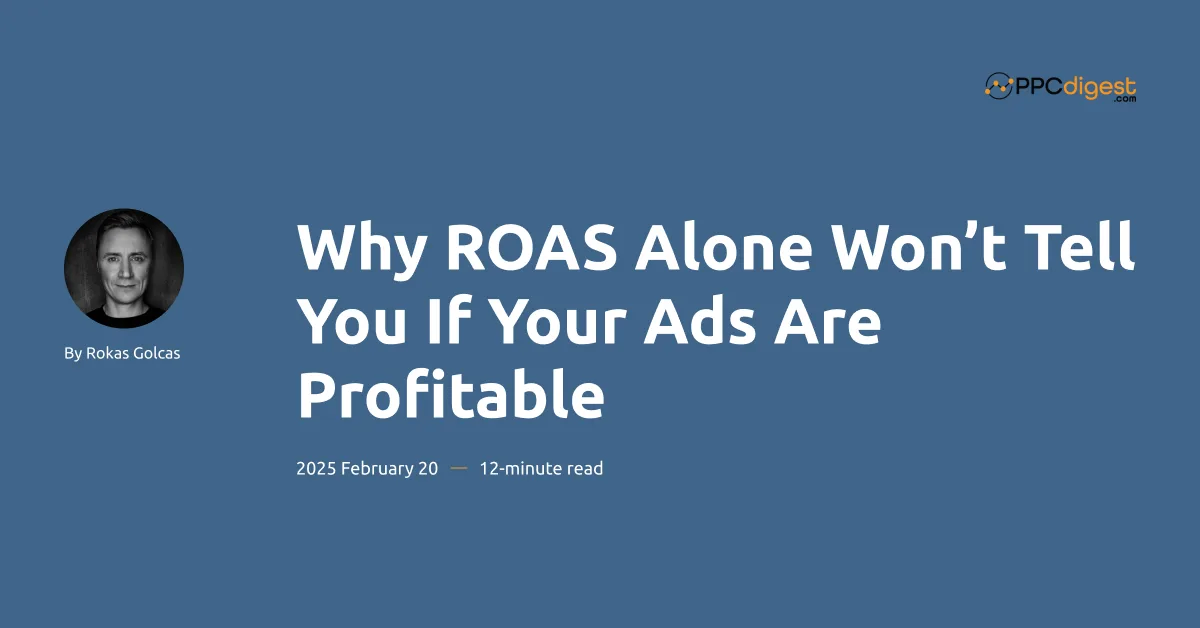
Many digital marketers see a high ROAS (Return on Ad Spend) as the ultimate sign of success—after all, making $5 for every $1 spent sounds great. But ROAS only gives a basic view of performance and doesn’t consider deeper financial and strategic factors.
Relying on it alone is like steering a ship without a proper compass—you may be moving, but not necessarily in the right direction. Let’s explore why ROAS isn’t enough and how to measure ad success more accurately.
The Deceptive Simplicity of ROAS
ROAS measures efficiency, not profitability. It answers the question, “How much revenue did my ads generate relative to their cost?” but ignores critical variables like production expenses, overhead, and customer retention costs.
For example, a campaign with a ROAS of 5:1 might seem stellar, but if your product’s profit margin is only 10%, you’re actually losing money. A $100 ad spend generating $500 in revenue sounds impressive—until you subtract the $450 in costs to produce and deliver those goods, leaving a mere $50 profit1.
This disconnect arises because ROAS doesn’t differentiate between revenue and profit. It treats every dollar earned as equal, regardless of the underlying economics. Beginners often overlook this distinction, focusing on top-line growth while neglecting bottom-line sustainability. Intermediate marketers might recognize the gap but struggle to quantify it, especially when operating in industries with slim margins or complex cost structures.
The Hidden Costs ROAS Ignores
Production and Operational Expenses
Every product or service has direct costs: materials, labor, shipping, and platform fees. ROAS excludes these entirely.
Consider an e-commerce brand selling handmade jewelry. A 400% ROAS ($4 revenue per $1 ad spend) might seem profitable, but if each piece costs $30 to make and sells for $40, the actual profit per sale is $10. If the ad campaign drives 10 sales ($400 revenue), the net profit is minus the $100 ad spend—breaking even. Without factoring in production costs, ROAS paints a misleadingly optimistic picture.
Customer Lifetime Value (CLV) and Retention
ROAS focuses on immediate transactions, not long-term relationships. A customer acquired through ads might make a first-time purchase of $50 (ROAS: 5:1) but return monthly for a year, spending $600 total.
Conversely, another customer might make a single $200 purchase (ROAS: 20:1) but never return. ROAS favors the latter, even though the former generates 3x more revenue over time. Businesses with subscription models or high repeat-purchase rates must prioritize CLV over short-term ROAS to avoid undervaluing loyal customers.
Attribution Complexity
Modern customer journeys are rarely linear. A user might click a Facebook ad, browse a blog post via organic search, and finally convert through a Google Ads click. ROAS credits the last touchpoint (Google Ads), ignoring the role of other channels in nurturing the sale. This “last-click” attribution inflates the perceived value of certain campaigns while undervaluing others.
For instance, branded search campaigns often show high ROAS because they target users already familiar with the brand—a result of prior marketing efforts1.
The Pitfalls of Misaligned Bidding Strategies
Automated bidding strategies like Target ROAS optimize for revenue, not profit. If your product margins vary widely—say, 5% on low-cost items and 40% on premium products—Google’s algorithm might prioritize promoting the lower-margin SKUs to hit ROAS targets. This drives revenue growth but erodes profitability. Manual bidding, while time-intensive, allows for strategic adjustments based on product-specific margins.
Similarly, campaigns targeting broad audiences might achieve high ROAS by attracting price-sensitive shoppers who buy discounted items. While this boosts short-term metrics, it can dilute brand equity and discourage full-price purchases from high-value segments.
Beyond ROAS: Metrics That Matter
Profit-Based KPIs
To align ad spend with profitability, calculate Profit on Ad Spend (POAS). This metric deducts all costs associated with a sale from revenue before comparing it to ad spend:
POAS = (Revenue – Cost of Goods)/ Ad Spend
In this case, the Cost of goods is all your costs, including goods, fees, etc.
For example, $500 revenue with $400 COGS and $100 ad spend yields a POAS of 1 (breakeven). This starkly contrasts with the 5:1 ROAS, revealing the campaign’s true impact.
Customer Acquisition Cost (CAC) Payback Period
CAC payback period measures how long it takes to recoup the cost of acquiring a customer. If your CAC is $100 and the customer generates $25/month in profit, the payback period is four months. ROAS doesn’t reflect this timeline, potentially encouraging strategies that front-load ad spend without ensuring long-term sustainability.
Assisted Conversions and Multi-Touch Attribution
Analyze how ads contribute to conversions across the entire funnel. Google Analytics’ Multi-Channel Funnels report reveals which campaigns assist conversions indirectly.
For example, a YouTube ad might not drive immediate sales but could increase branded search volume by 30%, boosting organic conversions. ROAS overlooks these “hidden” contributions.
However, GA4 attribution models are quite simple. If your revenue is $10 000+, I would recommend looking into paid attribution modeling tools. There are a lot of tools, for example Triplewhale.com or Hyros.com. If you use Shopify ,I think Northbeam.com can be a solution
Building a Profit-Centric Optimization Framework
Step 1: Integrate Profit Data into Your Platform
Instead of using Revenue in your Google Ads, use profit. It’s easy to do with your e-commerce tracking setup. Just push the profit metrics. This allows the algorithm to optimize for profitability instead of revenue.
Step 2: Segment Campaigns by Margin Tier
For Shopping and PMax campaigns, create separate campaigns for high-margin and low-margin products. Apply aggressive bids to high-margin items and conservative bids to others. This prevents budget allocation from skewing toward low-profit SKUs.
Step 3: Leverage Lifetime Value Models
Use offline conversion tracking to push revenue over a longer period. Then, optimize campaigns based on new data.
Simplier way is to use historical data to estimate CLV and adjust bids accordingly. If cosmetics customers have a 12-month CLV of $300, allocate more budget to campaigns attracting this cohort—even if their initial ROAS is lower.
Step 4: Adopt a Blended Attribution Model
Switch from last-click to data-driven attribution in Google Ads. This distributes credit across all touchpoints, providing a clearer picture of how ads influence conversions.
Explore other tools that will give you additional insights on attribution. What you must remember is that none of the tools are 100% accurate. So when you get a tool, change campaigns based on its data and then check if your revenue/profit actually increased. And I don’t mean look in the platform, look in your bank account.

Blogging gives me a chance to share my extensive experience with Google Ads. I hope you will find my posts useful. I try to write once a week, and you’re welcome to join my newsletter. Or we can connect on LinkedIn.